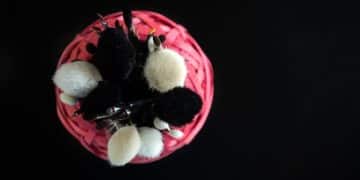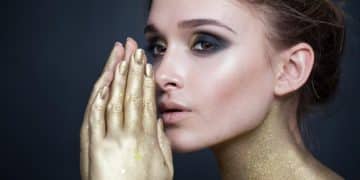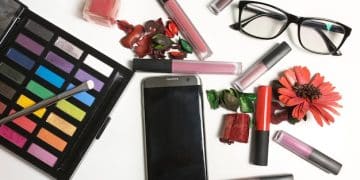The Ultimate Guide to Makeup Brushes: Choose the Right Ones!
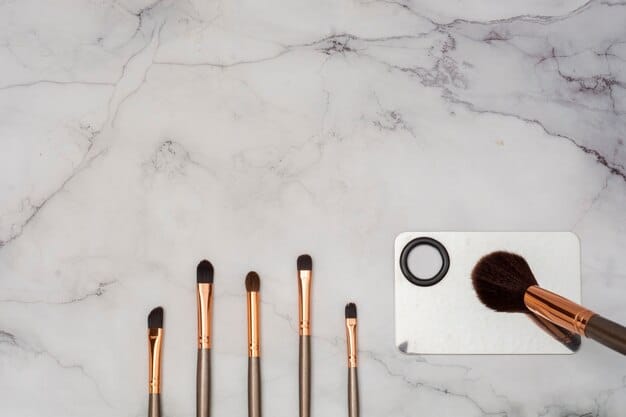
Choosing the right makeup brushes can dramatically improve your makeup application, ensuring a flawless finish and enhancing your natural beauty with the perfect tools for every product and technique.
Navigating the world of makeup brushes can feel overwhelming. With countless shapes, sizes, and materials available, how do you choose the right ones for your needs? This ultimate guide to choosing the right makeup brushes for your needs will break down everything you need to know, from understanding different brush types to caring for your tools, ensuring a flawless makeup application every time.
Understanding the Basics of Makeup Brushes
Before diving into specific brush types, it’s essential to understand the basic components of a makeup brush and how they affect performance. This foundational knowledge will empower you to make informed decisions and select brushes that align with your desired makeup looks.
Anatomy of a Makeup Brush
A makeup brush consists of three main parts: the bristles, the ferrule, and the handle.
- Bristles: These can be natural or synthetic and determine how the brush picks up and applies product.
- Ferrule: This metal part connects the bristles to the handle and secures the bristles in place.
- Handle: The handle provides grip and control during application, influencing precision and comfort.
Selecting brushes with high-quality components ensures longevity and optimal performance. Consider factors like bristle softness, ferrule durability, and handle ergonomics to enhance your makeup routine.
Natural vs. Synthetic Bristles
The choice between natural and synthetic bristles depends on the type of product you’re using and your personal preferences.
- Natural Bristles: Ideal for powder products, as their porous texture picks up and distributes pigment evenly.
- Synthetic Bristles: Best for cream and liquid products, as they don’t absorb as much product and are easier to clean.
Understanding the properties of each type allows you to optimize product application and achieve a professional finish. If you are vegan or have allergies, synthetic brushes are the best option.
In conclusion, understanding the basic components and materials of makeup brushes is crucial for making informed purchasing decisions. By considering the anatomy and bristle types, you can select brushes that are best suited for your makeup needs and preferences.
Essential Brushes for a Complete Makeup Kit
Building a makeup brush collection doesn’t require every brush on the market. Focusing on a few essential brushes can cover most makeup needs. Knowing which brushes are the most versatile will help you create a comprehensive kit without overspending.
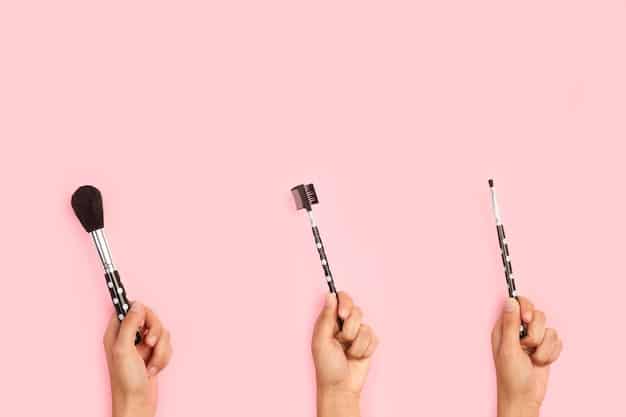
Foundation Brush
A good foundation brush is essential for creating a smooth, even base. Look for brushes with densely packed bristles to buff the product into the skin seamlessly.
Concealer Brush
A small, tapered concealer brush is perfect for precise application in hard-to-reach areas like around the eyes and nose.
- Powder Brush: A large, fluffy brush for applying setting powder all over the face.
- Blush Brush: An angled brush for applying blush to the apples of the cheeks.
- Eyeshadow Brushes: A variety of brushes for applying, blending, and defining eyeshadow.
These essential brushes form the foundation of any makeup kit, allowing for versatile application and professional-looking results. Investing in high-quality brushes ensures durability and optimal performance.
In summary, selecting the right essential brushes is key to building a versatile makeup kit. By focusing on high-quality foundation, concealer, powder, blush, and eyeshadow brushes, you can achieve flawless makeup application across various looks.
Brushes for Face Makeup: Achieving a Flawless Base
Achieving a flawless base starts with the right face makeup brushes. These tools help to apply and blend foundation, concealer, and powder seamlessly, creating a smooth canvas for the rest of your makeup.
Foundation Brushes: Flat vs. Buffing
There are two main types of foundation brushes: flat brushes and buffing brushes.
Flat foundation brushes are best for applying liquid foundation in thin, even layers. Buffing brushes, on the other hand, are ideal for blending foundation into the skin for a natural, airbrushed finish.
Concealer Brushes: Precision is Key
Concealer brushes come in various shapes and sizes, but precision is always key. Opt for a small, tapered brush to target specific areas like blemishes and dark circles.
- Use a damp sponge or stippling brush for a natural skin like finish
- Use a dense concealer brush for maximum coverage
Choosing the right concealer brush ensures seamless blending and targeted coverage, resulting in a flawless complexion.

In conclusion, the right face makeup brushes are essential for achieving a flawless base. By understanding the differences between flat and buffing foundation brushes and focusing on precision with concealer brushes, you can create a smooth and even canvas for your makeup.
Brushes for Eye Makeup: Defining and Enhancing Your Eyes
Eye makeup brushes are essential for creating a variety of looks, from natural to dramatic. With the right tools, you can define your eyes, blend eyeshadow seamlessly, and achieve professional results.
Eyeshadow Brushes: Different Shapes for Different Purposes
Eyeshadow brushes come in various shapes and sizes, each designed for a specific purpose.
- Flat Shader Brush: For packing color onto the lid.
- Blending Brush: For blending eyeshadow seamlessly.
- Pencil Brush: For precise application in the crease and along the lash line.
Understanding the purpose of each brush type is crucial for achieving desired eye makeup looks. Experiment with different brushes to find the ones that work best for your style and technique.
Eyeliner Brushes: Achieving Precision
Eyeliner brushes are essential for creating sharp, defined lines. Choose a brush with a fine tip for precise application.
Angled brushes are great for applying gel eyeliner, while fine-tipped brushes are ideal for liquid eyeliner. Practice and patience are key to mastering eyeliner application with brushes.
In summary, eye makeup brushes are essential for defining and enhancing your eyes. By understanding the different shapes and purposes of eyeshadow brushes and using precise eyeliner brushes, you can create a wide range of eye makeup looks.
Cleaning and Caring for Your Makeup Brushes
Properly cleaning and caring for your makeup brushes is essential for maintaining hygiene and extending their lifespan. Dirty brushes can harbor bacteria and lead to skin irritation, while neglected brushes can deteriorate quickly.
- Wash your brushes regularly – at least once a week.
- Use a gentle shampoo or brush cleanser to clean with
- Rinse and dry them carefully.
Why Cleaning Is Important
Cleaning your makeup brushes removes product buildup, dirt, and bacteria. This not only prevents skin irritation and breakouts but also ensures that your brushes perform optimally.
How to Clean Your Brushes
To clean your makeup brushes, wet the bristles with lukewarm water and apply a small amount of gentle shampoo or brush cleanser.
- Gently massage the bristles to remove product buildup.
- Rinse thoroughly with lukewarm water until the water runs clear.
- Squeeze out excess water and reshape the bristles.
Lay the brushes flat or hang them upside down to dry, avoiding direct sunlight or heat.
In conclusion, cleaning and caring for your makeup brushes is essential for maintaining hygiene and extending their lifespan. By cleaning your brushes regularly and using gentle cleaning products, you can keep your brushes in top condition and prevent skin irritation.
Choosing Brushes Based on Skin Type and Makeup Products
Selecting the right makeup brushes also depends on your skin type and the types of makeup products you use. Different skin types and products require specific brush materials and shapes to achieve the best results. Understanding these nuances can significantly improve your makeup application.
For Dry Skin
If you have dry skin, opt for brushes with softer bristles that won’t irritate your skin. Natural bristles are often a good choice for powder products, while synthetic bristles work well for cream and liquid products.
For Oily Skin
For oily skin, consider using brushes with synthetic bristles, as they don’t absorb as much product and are easier to clean. This helps prevent product buildup and reduces the risk of breakouts.
- Cream Products: Synthetic bristles are ideal, as they don’t absorb too much product and are easy to clean.
- Powder Products: Natural bristles work well, but synthetic options are also suitable and more hygienic.
- Loose Pigments: Use Dense brushes that can pick up shimmer and glitter
In summary, your skin type and the makeup products you use should influence your brush selection. By considering the properties of different brush materials and shapes, you can achieve a flawless makeup application that caters to your specific needs.
| Key Point | Brief Description |
|---|---|
| ✨ Brush Anatomy | Understand bristles, ferrules, and handles. |
| 🌿 Natural vs. Synthetic | Natural for powder, synthetic for liquids. |
| 👁️ Essential Face Brushes | Foundation, concealer, powder, blush. |
| 🧼 Brush Hygiene | Clean brushes weekly for skin health. |
Frequently Asked Questions
▼
You should aim to clean your makeup brushes at least once a week to prevent bacteria buildup and ensure optimal performance. For brushes used daily, consider cleaning them more frequently.
▼
Natural bristles are porous and ideal for powder products, while synthetic bristles are non-porous and better suited for cream and liquid products. Synthetic brushes are also vegan-friendly.
▼
While you can, it’s best to use separate brushes for different eyeshadow colors to prevent color mixing and ensure clean, precise application. Alternatively, clean the brush between colors.
▼
Lay your brushes flat on a towel or hang them upside down to dry. Avoid using a hairdryer or placing them in direct sunlight, as this can damage the bristles and affect their shape.
▼
A beginner should focus on a foundation brush, concealer brush, powder brush, blush brush, and a few basic eyeshadow brushes. These will cover most makeup application needs.
Conclusion
Choosing the right makeup brushes can significantly elevate your makeup routine, transforming your application and enhancing your overall look. By understanding the different types of brushes, their uses, and how to care for them, you can create a flawless finish every time. Investing in quality brushes is an investment in your beauty and confidence.



